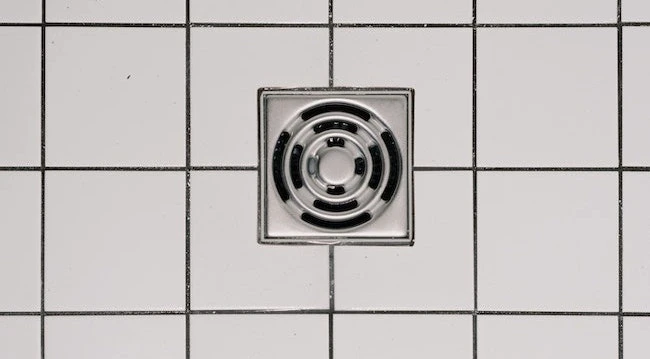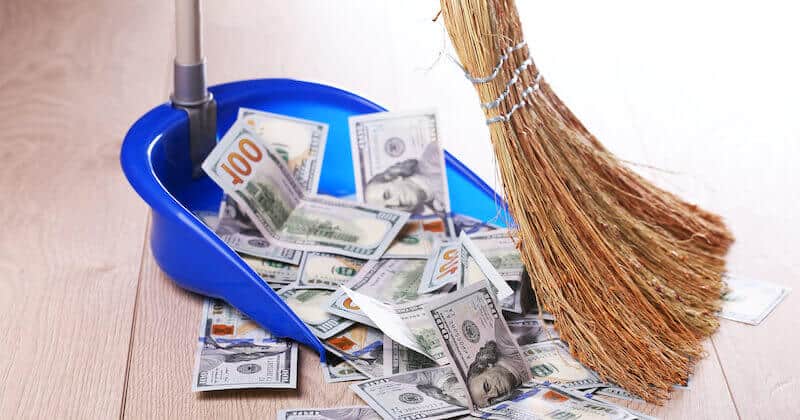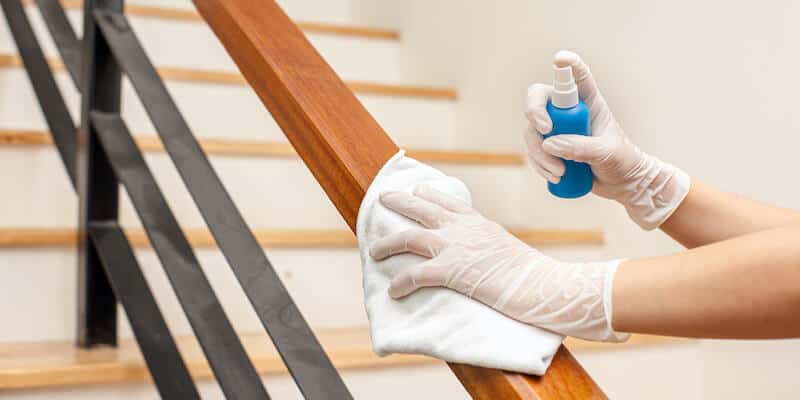
You’ve just grouted a tile floor, and you are delighted by the outcome. But now comes the daunting part for many people – cleaning floor grout on the tiles.
Luckily, our experience in this field will come in handy for you. In this article, you will learn how to clean floor grout without scrubbing the bathroom or kitchen tiles and by using natural products. In a nutshell, you will learn how to:
- Sweep the Floor
- Make a Cleaner
- Apply the Cleaner
- Sit and Wait
- Wipe it Away
- Seal the Cleaned Grout

Let’s get the ball rolling and leave your sponge for another day. Here is an easy solution.
To clean tile grout without scrubbing you have to sweep the floor, make a solution mixing water with baking soda or vinegar, apply the solution, let it sit, wipe it off and seal the grout.
“With the grout cleaner I’ve developed, anyone can effectively clean their grout without the hassle of scrubbing. It’s not just about making the task easier; it’s about making it efficient, too. When you’re armed with the right tools, your cleaning tasks become less daunting.”
Ulysses Kingston, Inventor & Cleaning Industry Veteran
The Easiest Way to Clean Floor Grout Without Scrubbing
Step 1: Sweep the Floor
First and foremost, you want to sweep the tiled floor before you get round to doing the cleaning process.
Do your regular cleaning routine. Use a soft bristle brush to collect any dirt and dust from your bathroom. Alternatively a standard vacuum cleaner will do the job just as well, if not better and quicker.
Now let’s see how to make the best homemade tile grout cleaner for removing dirty grout.
Step 2: Make a Cleaner
There are many natural ways you can use for cleaning dirty grout lines, including hydrogen peroxide, baking soda, and vinegar.
One of the most powerful one is a mixture of hydrogen peroxide and baking soda. Follow these steps to make a homemade tile grout cleaner and get rid of those pesky grout stains.
- Prepare a clean bowl.
- Add one cup of baking soda to it.
- Then, add a few drops of hydrogen peroxide into the bowl.
- Add a few drops of water and a few drops of lemon juice if you like.
- Stir everything together until it looks like a sticky baking soda paste.
If you opt for a vinegar grout cleaner for cleaning grout and tile, follow these steps:
- Prepare a clean spray bottle.
- Pour a glass of hot water into it.
- Add half a cup of baking soda.
- Squeeze in some lemon juice.
- Pour two glasses of white vinegar.
- Shake it well.
Since the vinegar cleaner is slightly milder than the mixture of baking soda and hydrogen peroxide, you can spray larger quantities of it for the grout cleaning process.
Some people like to use a clorox gel toilet bowl cleaner and an old toothbrush, too. You don’t want to leave it on for more than 10 minutes. If you use a commercial cleaner, be careful because some of them contain ammonia.
In the end, it is up to you to decide. Choose the method you are most comfortable with from all of these.
Step 3: Apply the Cleaner
Once you have made your grout cleaning solution, it is time to apply it.
Use a spatula to spread the paste made of baking soda and hydrogen peroxide onto the dirty grout tiles. If you are using the liquid grout clean mixture, spray generously over the grout lines, cleaning the most of the surface and the mineral build-up.
Make sure you are wearing protective rubber gloves as some of these ingredients might be too strong specially in closed areas, getting in touch with the chemical might cause pain and rashes. Leave the windows open when using any type of bathroom grout cleaning products.
Step 4: Sit and Wait
After the application, allow approximately 15 minutes for the peroxide grout mixture to start doing the job and at least half an hour for the vinegar cleaner to start displaying a chemical reaction. It will work on grease, scum and mold.
Get out of the bathroom at this point. Make sure your family or pets don’t go into the bathrooms during this time. You can use this time to relax, read or do other house chores. The time will very depending on the things that you used for the solution.
Step 5: Wipe it Away
Don’t be surprised if you see some bubbles forming on your bathroom tiles. At this point, you need to wipe the stains using a damp microfiber cloth.
Once you have wiped away the cleaning solution, use dish soap or a mild detergent and warm water to go over the tiles with a mop to remove any loose or stubborn dirt.
Step 6: Seal Cleaned Grout
Now that you have got rid of all the undesirable grout lines on the tiles, you want to seal the cleaned grout in order to protect the natural stone tiles and maintain the same color. Sealing will also deter any water or chemical damage, stains, or abrasion.
To seal the cleaned grout, you can opt for penetrating sealers or topical sealers. Penetrating sealers are designed for natural stone, and as their name implies, they penetrate into the cleaned grout.
On the other hand, topical sealers are meant for concrete and pavers, and they sit on top of the cleaned grout. Penetrating sealers also form a protective layer that’s not slippery, with a nice, matte finish, which is not the case with the topical ones.
If the Grout Stains Persist
Here are some of the solutions that can work if the grout stains persist. Frankly, these are not without any negative effects, but if you really need to get rid of the stains, they’ll do the job. You might have to repeat more than two times if the stains are really stuck.
Oxygen Bleach Solution
Now, oxygen bleach (clorox bleach) is very harsh and said to be the ultimate grout cleaner for the worst stains. However, it can have a negative effect both on you and on your bathroom tiles. For what it’s worth, oxygenated bleach is at least milder than chlorine bleach. This is not recommended for all types of tile, so make some research before using bleach.
That said, it is not advisable to use it frequently, but you can get away with it this one time to revitalize bathroom tiles. The steps are as follows:
- Apply the undiluted compound onto the bad stains.
- Allow 10 to 15 minutes to react without scrubbing.
- Allow fresh air in and ventilate the area.
- Wipe the bathroom tiles away with a damp cloth.
- Give a once over with a mop and soapy water to remove left over Clorox bleach.
Alkaline Cleaners
An alkaline cleaner is a store-bought grout cleaner specifically designed for getting rid of grout caused by mold or mildew. That said, it cleans grout on the bathroom tiles effectively, even better than other cleaning options.
To administer the product, follow the manufacturer’s guidelines on the packaging since there is not a universal, hard-and-thrust rule I can give you here.
Don’t leave it to react longer than advised. Leave windows open when conducting the procedure. If you are not 100% sure, try other methods first.
Mild Brushing
What I am referring to by “Mild Brushing” is using a soft toothbrush, a slightly more sturdy paintbrush, or a soft bristle brush in combination with the right cleaner or dishwashing liquid to clean grout.
This will hardly damage the multiple bathroom tiles, and it is even milder in removing stained grout than an alkaline tile cleaner or bleach. It will not only help you remove grout but also loose dirt, with minimal scrubbing. You can easily remove pretty much anything if you combine it with the right chemical.
Steam Cleaners
Finally, you can remove any floor grout without scrubbing or using chemicals by using a steam cleaner. Fill it with water, set it to steam, and attach an appropriate brush or nozzle onto it.
Using back-and-forth strokes, start scrubbing the tile grout. Pause often to remove the dirt before continuing with steam cleaning. This will prevent the spread of the grime on your floor.
If you don’t want to invest money on a hardwood floor machine, consider hiring a professional to get the job done.
A Word of Caution
Some cleaners might be more abrasive and aggressive than others. This is especially true of chemical ones, bleach, toilet bowl cleaners, or alkaline cleaners. Always follow the instructions provided by the manufacturer.
It’s important to choose the right cleaner for your specific material. Some cleaning agents might affect floors or the health of the homeowners. Make sure to have a well ventilated place.
With this in mind, always use eye and hand protection. Leave the windows open to let the air in. Don’t let your children or pets play around while you are cleaning the floor tiles.
Conclusion
Cleaning grout on tile floors can be a bit of a nuisance. But with this guide, you can learn how to clean ceramic tile bathroom grout with minimal scrubbing and minimal effort.
This will do wonders for your knees, hands and elbows.
Some people prefer to use alkaline cleaners, but I recommend using hydrogen peroxide, baking soda, and vinegar. After making the cleaner, apply it and wait for it to react. Then, wipe it with a damp cloth.
If the cleaning power of the product is not strong enough to remove the stubborn stains, consider using bleach, a steam cleaner, or a scrub brush.
References
https://dictionary.cambridge.org/us/dictionary/english/grout
https://www.homedepot.com/c/ah/how-to-grout-tile/9ba683603be9fa5395fab90116d5c33





Using natural products like vinegar and baking soda is not only cost-effective but also safe for both ceramic and porcelain tiles, without damaging their shine or color.
Ever since I switched to vinegar and baking soda for my tile floor cleaning, not only has it been cost-effective but also better for my respiratory health. And just as Reagan remarked, neither the shine nor color of the tiles was compromised!
I completely agree with you, Thelma. Having used vinegar and baking soda solution for over twenty years to clean various surfaces, I can vouch for its effectiveness and affordability as well. It’s a fantastic method that transforms grubby grout lines into looking brand new without harsh chemical exposure.